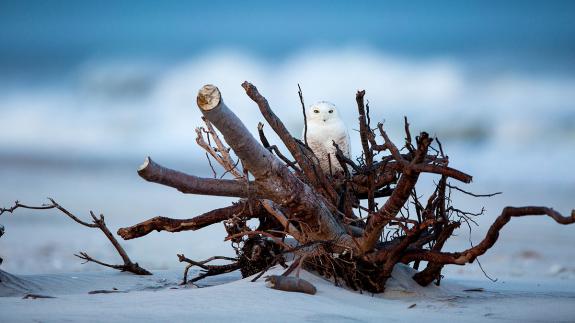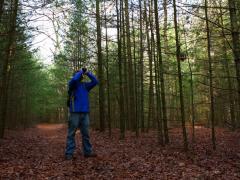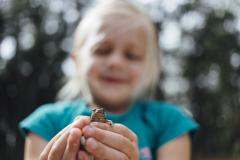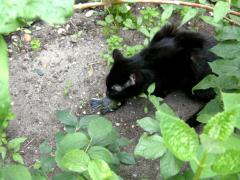Responsible Wildlife Viewing
Learn how to become a responsible wildlife watcher and maximize your outdoor experiences.
 It's important to put the overall well being of the species and it's environment before your own self interests when it comes to wildlife viewing. Photo by Northside Jim
It's important to put the overall well being of the species and it's environment before your own self interests when it comes to wildlife viewing. Photo by Northside Jim
Responsible wildlife watching is good for both people and wildlife. You are able to enjoy viewing wildlife while also having low impact on wildlife. Things to consider include where to find wildlife, how to approach wildlife, handling of wildlife, and keeping pets and wildlife separate, not just physically but also avoiding the common mistake of believing wildlife can become pets. Before diving into these topics however, a review of some basic outdoor etiquette may be helpful.
- Carry In, Carry Out
- Respect Private Property
- Keep Quiet
- Leave a Small Footprint or None at All
- Share Wildlife with Others
- Respect the Wild in Wildlife
- Don't Pressure Wildlife
- Approaching Wildlife
- Handling Wildlife
- Pets & Wildlife
CARRY IN, CARRY OUT
 Zoom+ Pollution is a major threat to wildlife, especially marine species. © Ingrid Taylar
Zoom+ Pollution is a major threat to wildlife, especially marine species. © Ingrid Taylar
No one enjoys seeing litter when trying to enjoy the outdoors, whether it is during a leisurely stroll along the beach or a rigorous hike through a forest. Unfortunately, much of the litter observed outdoors often comes from miles away, carried by the wind or water to its final destination. However, one of the easiest steps that anyone can do is to not litter - carry out anything you have carried in, such as food wrappers, water bottles, plastic bags, etc. Not only is litter unsightly, but it can also often prove dangerous to wildlife. Wildlife can become entangled in discarded fishing lineor may accidentally swallow plastics, mistaking them for food. Many public open spaces have garbage cans located near their entrances/exits, so you may use them to discard your trash. If no trashcans are available, then be prepared to take your trash home with you and dispose of it properly.
RESPECT PRIVATE PROPERTY
It is against the law to trespass on someone else’s property. Avoid potential arguments with landowners and respect private property when wildlife viewing. Many public open spaces border privately-owned land so take a map with you and be aware of property boundaries. Obey posted “No Trespassing” signs. Such signs may not only alert you to the extent of private land, but it may be a warning of potential hazards on the property such as sinkholes or unleashed dogs. Should you see wildlife you’re interested in on private property, unless you have the property owner’s permission, remain on public land and use binoculars or a spotting scope.
KEEP QUIET
Nothing ruins the serenity of the wildlife viewing quite like the loud ring of a cell phone or yelling. While viewing wildlife, it is a good idea to use your “indoor voice”. Keep noise to a minimum so you don’t disturb wildlife or other wildlife watchers.
 Zoom+ A birder identifies a songbird using binoculars. © Ben Wurst
Zoom+ A birder identifies a songbird using binoculars. © Ben Wurst
LEAVE A SMALL FOOTPRINT OR NONE AT ALL
Create minimal impact on the land and wildlife. If regulations are posted within public spaces regarding trail use, follow them. Such regulations are posted in order to maintain the usefulness and character of trails. For instance, not all walking trails are suitable for mountain biking. Additionally, if trails are available, stay on them. Going off trail, whether by foot or bicycling, may destroy vegetation, harm sensitive wildlife and habitats, and cause soil erosion. Having minimal impact also means leaving things as you found them. If you turn over a log or rock in order to look for wildlife, return it to its original position when moving on. Otherwise, you may unintentionally destroy the home of an animal that lived under it. While such an act might seem trivial, consider the impact of hundreds of people turning over logs or rocks over and over again along a trail. Eventually, the wildlife that did use that area would leave, having been disturbed too many times.
SHARE WILDLIFE WITH OTHERS
Aside from not harming wildlife by following simple outdoor etiquette, such guidelines also allow others to enjoy the same nature experience that you enjoyed. Responsible wildlife viewing is about creating a positive experience for you, while not diminishing it for others. Also, don’t be shy to share responsible wildlife viewing tips with others, particularly those who may be “breaking the rules” whether knowingly or unknowingly. Keep in mind that many people may not be as familiar with wildlife or the outdoors as you may be. They may not understand the potential negative consequences of being to close to an eagle’s nest or leaving food for a bear. If you know such behavior is wrong, make them aware of it too. In such instances, you may be doing them an enormous favor in the long run, preventing them from breaking laws or saving them from potential physical harm.
RESPECT THE “WILD” IN WILDLIFE
The most important basic tip to remember while viewing wildlife is that wildlife is just that, “wild”. Some wild animals may look very cute and harmless, but often they can be quite dangerous. Seals, for example, may look like adorable fin-footed puppies, but they have mouths full of sharp teeth and they will not hesitate to use them if they feel they are in danger. To most wildlife, an approaching human is a threat and they will react as if a predator is confronting them. Never expect wildlife to behave as a pet might – most have had no direct contact with humans, and those that have, often have had negative interactions.
DON’T PRESSURE WILDLIFE
Wildlife is not there to perform for you. They are on their own schedule, so if a heron feels like standing motionless for an hour, then let it – don’t attempt to make it move. Wildlife viewing is often unpredictable and not always full of the action seen in nature documentaries. So sit back, relax, watch, and wait…and then watch and wait some more.
APPROACHING WILDLIFE
HOW CLOSE IS TOO CLOSE?
When watching wildlife, one of the greatest problems is how to get close enough to an animal to have a good view of it without disturbing it. It should be the goal of every wildlife watcher to never approach any wildlife so closely that it reacts to your presence. While it may not seem like a big deal that an animal has noticed your presence and makes an effort to flee, there are potential negative consequences. By approaching an animal too closely, you may unintentionally cause a nest failure, injury or death, or at the very least, you may cause the animal to expend precious energy making it more difficult to survive. Remember most wildlife are surviving meal to meal – they don’t have a pantry full of snacks to go to when they are hungry. They have to search and often capture their food. Causing an animal to expend energy running or flying away from you, may be the energy it needed to hunt and feed itself or hungry babies.
 A birder identifies a juvenile black skimmer from a distance at Forsythe NWR. © Ben Wurst
A birder identifies a juvenile black skimmer from a distance at Forsythe NWR. © Ben Wurst
Additionally, the well-being of wildlife, not your viewing pleasure, should always be the first priority. If you see other wildlife watchers in an area, do not congregate. That will not only diminish the wildlife watching experience for others, it will result in a larger group, more likely to disturb wildlife. For example, too often, overly-enthusiastic bird watchers who have received information regarding a rare sighting, will converge on a locale, resulting in a crowd under a nesting tree. This behavior ultimately harms the birds, causing much disturbance and stress.
Nesting animals are often very intolerant of disturbance by other animals or people. If a nesting animal, such as a bird, is disturbed often enough, there is a strong chance that it will abandon its nest (and eggs). Also, for birds which may already have young but have not yet fledged, disturbance may cause great stress for the adult birds and could reduce their capacity to feed their own young (since they would spend more time defending the nest). Also, young birds could attempt to leave the nest prematurely and end up injured or dead. Therefore, if a nest is located, give it a wide berth.
 Zoom+ The irruption of snowy owls along the New Jersey shore in during the last two winters has been an amazing opportunity to see such a rare species. Albeit many have put their own self interests before that of the birds. Photo by Northside Jim
Zoom+ The irruption of snowy owls along the New Jersey shore in during the last two winters has been an amazing opportunity to see such a rare species. Albeit many have put their own self interests before that of the birds. Photo by Northside Jim
Chasing wildlife or even simply approaching too close, may even put the animal at great risk from injury or even death. For instance, an inappropriate wildlife viewing approach may cause an animal to seek refuge across a road, thereby increasing the risk of it being hit by a car. Dolphins and whales approached too closely by boats could become seriously injured or killed by propellers. Also, causing hidden wildlife to take flight could expose it to predators which would have otherwise not known it was there. Lastly, causing an animal to change its behavior results in that animal expending more energy than it otherwise would have. For instance, seals often rest on beaches but are very sensitive to disturbance due to their relative lack of mobility while on land. If approached too closely, they will flee into the relative safety of the water. This causes them to use more energy while also potentially causing them to frantically enter the water where a predator could be lurking.
So, how close is too close? There’s no simple answer, unfortunately. It depends partially upon the species being observed and what portion of the life cycle (i.e. nesting) that animal may be engaged in. This is another instance when knowing a little bit about the species may prove helpful. However, when in doubt, always err on the side of caution and provide a large buffer between you and the wildlife which you are viewing. Always strive to avoid causing wildlife to react to your presence and keep the safety of both yourself and the wildlife in mind. Use equipment like binoculars and spotting scopes to bring the wildlife to you.
For some species, specific laws have been created in order to protect them from harassment, one form of which would be disturbance. Such laws include the Marine Mammal Protection Act, the Federal Endangered Species Act, and the New Jersey Endangered Species Conservation Act. All of the regulations outlined within the preceding laws should be respected when viewing wildlife responsibly.
HANDLING WILDLIFE
A frequent question posed by new wildlife watchers, particularly children, is whether they may pick-up or touch an animal that they find. The best and short answer is “No”. The most responsible wildlife viewing would be to not touch or handle any animal. For some groups of species such as mammals and birds, that is almost always the case. However, there is an immeasurable educational experience gained by handling wildlife such as frogs, turtles or insects. Such an experience, which may help foster an appreciation and respect for wildlife, is so valuable that exceptions may be made. That being said, there are inappropriate times and allowable times when handling wildlife may occur. Before outlining some of those, first consider the potential problems caused by handling wildlife.
 Zoom+ In many cases, when children handle wildlife it can instill a life long appreciation for them. Photo by Ben Wurst
Zoom+ In many cases, when children handle wildlife it can instill a life long appreciation for them. Photo by Ben Wurst
The first potential problem with handling wildlife, as most mothers would argue, is the potential for getting germs from wildlife. It is true that some wildlife that children will touch have the potential to cause harm. Bees may sting, garter snakes may bite, crabs may pinch, and turtles may have germs. That is definitely something to consider when handling wildlife – “will this hurt me?” However, more often than not, the wildlife in question is at greater risk at being harmed by the human handling it. It may be dropped or handled too roughly. If handling an animal, or if supervising a child who is, be sure to be gentle, keeping in mind how small the animal is relative to the human touching it and how stressed it most likely is. On account of stress, keep any handling to a minimal amount of time. An argument for not handling any wildlife is that you may, unknowingly, leave your scent on the animal, making potential predators or prey more aware its presence.
If you pick-up any wildlife, be sure to return it to the location where you found it. There is most likely a good reason why the animal was at the spot where it was found – perhaps it was a damp log, a warm stone, or a sandy riverbed. The animal was most likely there because it is suitable habitat. Not returning the animal to that spot may result in its death. For instance, placing a salamander on a warm dry stone rather than near its damp log could cause it harm. Also, freshwater mussels which are not returned to their streambed properly, may become dislodged from the substrate and be swept downstream or be more visible to predators.
While the potential negatives of handling wildlife arguably outweigh the positives, there is no escaping the reality that people, particularly children, will want to touch animals – this is why petting zoos and aquarium touch tanks are so popular. The goal then should be to do so in manner in which causes no harm to the animal while also providing an enriching “hands-on” experience. In so doing, we may be able to create the next generation of wildlife enthusiasts and biologists.
When discussing handling wildlife, we need to also address the issue of injured animals and “orphans.” “Orphans” is in quotations because, all too often, well-intentioned individuals will “rescue” a baby animal, believing that it has been abandoned by its parents or that the parents are dead. More often that not, the parents are alive and nearby, but may not make their presence known because you are nearby. This is especially common with baby birds. Well-intentioned “rescuers” may actually become “kidnappers”. If a baby animal is found, it is usually in the animal’s best interest that you leave it alone. However, in cases where the animal is in certain harm, intervention may become necessary, whether it be placing a baby bird back in its nest or taking an injured animal to a wildlife rehabilitator. Our policy on rescuing injured wildlife is one that we only get involved with when the cause of that injury is man-made. For a list of certified wildlife rehabilitators in New Jersey, please visit the Division of Fish and Wildlife’s website or the New Jersey Association of Wildlife Rehabilitators.
PETS & WILDLIFE
 Zoom+ A major threat to beach nesting birds during the summer are loose dogs. When birds are disturbed their young become vulerable to predation. © CWF
Zoom+ A major threat to beach nesting birds during the summer are loose dogs. When birds are disturbed their young become vulerable to predation. © CWF
When one thinks about responsible wildlife viewing, household pets are not the first thing that comes to mind. However, it is worth mentioning that it is important to maintain control over your pets when in the outdoors. With dogs, this means cleaning-up after their waste, keeping them on leashes, and making sure that they do not chase, grab, dig-up, or otherwise interact with wildlife. If allowing your dog to go off-leash on beaches, be aware that seals may be present in the winter and that they will bite in order to defend themselves. During the summer, beaches are home to beach nesting birds whose eggs and young could easily be harmed by an off-leash dog. Pet-wildlife interactions not only expose a risk of harm to wildlife but also keep in mind that that it is possible for wildlife to injure and spread disease to your pet.
When it comes to cats, it is crucial, for both the cat’s benefit and for the nearby wildlife, that the cat remain indoors. Cats allowed to wander outside of homes will, no matter how well-fed they are or how many bells they wear on their collar, kill wildlife such as songbirds. Scientists estimate that nationwide, cats kill hundreds of millions of birds, and more than a billion small mammals, such as rabbits, squirrels, and chipmunks, each year (American Bird Conservancy, 2010). The domestic housecat is not a species which is native to the wilds of North America. Therefore, the argument that they are only doing what nature intended is false. In addition, the argument that housecats will become bored if not allowed outdoors is not based upon fact. Rather, it is humans projecting their feelings onto the cat. Lastly, allowing cats outdoors also exposes them to a great deal of potential harm: disease, parasites, fights with other animals, and the possibility of being hit by a car. So, for the benefit of wildlife surrounding your home as well as that of your own cat, keep all cats indoors.
 Zoom+ Outdoor and feral cats kill millions of birds each year, including rare species. © Marcel van Valen
Zoom+ Outdoor and feral cats kill millions of birds each year, including rare species. © Marcel van Valen
Related to the issue of keeping cats indoors is the increasing problem of irresponsible pet owners setting their pets “free”. Captive snakes, frogs, and even fish are often released into the wild by pet owners who can no longer care for them or no longer want to care for them. This may have a negative impact on native wildlife. First, there is the potential that captive-bred pets, which are often from other areas of the globe, may be carrying diseases for which native species lack immunity. Thus, native species may acquire diseases and/or parasites for which they have no defense. Furthermore, there is a risk that released pets could prey upon native wildlife or out-compete with them for food or other resources. Although this problem is much greater in warmer locations than New Jersey (south Florida, for instance), it occurs in New Jersey as well. If you can no longer care for a pet, contact a local pet store, zoo, or animal control to inquire about potential placement. Under no circumstances should a pet ever be released into the wild.
Just as pets should not be released into the wild, wildlife should not be taken home as pets. First, collecting native wildlife without proper permits is illegal. Second, the collecting of native wildlife, particularly reptiles and amphibians, has resulted in several species becoming more imperiled. The Eastern Box Turtle is currently considered a species of Special Concern status in New Jersey, largely due to so many having been taken from the wild as pets. Therefore, enjoy wild animals where they belong – in the wild. Pets should only come from a pet store (or animal shelter).
RESOURCES and More information
- Federal & state laws & regulations Marine Mammal Protection Act
- Federal Endangered Species Act
- Federal Migratory Bird Treaty Act
- NJ Endangered Species Conservation Act
- NJDEP Wildlife Management Area Regulations
- NJDEP Wildlife Relocation Policy
- NOAA Fisheries Service Responsible Marine Wildlife Viewing
- NOAA Fisheries Service Marine Mammal Viewing in the Northeast
- NOAA Fisheries Service Whale Watching Guidelines
- NOAA Fisheries Service Right Whale Approach Regulations
- NOAA Fisheries Service Seal Watching Guidelines
- State certified wildlife rehabilitators






